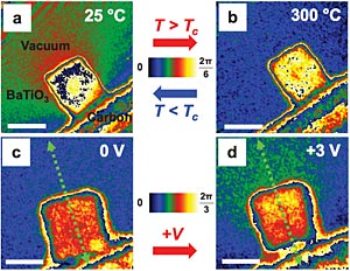Ferroelectric materials can store digital information just like their cousins, the ferromagnetic materials. Similar to the ferromagnetic materials being characterized by magnetic dipoles of either north or south and their capability to align themselves on a bigger scale to produce either attractive or repulsive magnetic force, ferroelectric materials also exhibit molecular level dipole moment comprising positive and negative electric charges.
 Polarization images of ferroelectric nanocubes captured using electron holography
Polarization images of ferroelectric nanocubes captured using electron holography
While magnetization in ferromagnetic materials can be manipulated by applying an external magnetic field, the polarization of ferroelectric materials can also be manipulated by applying an external electric field.
Magnetic memory devices store information in the form of bits (ones and zeros) by flipping the dipole moment of ferromagnetic materials to represent the ones and zeros. These materials can retain the information even when they are switched off. Memory devices can be built out of ferroelectrics too by toggling between the two electric states to represent the zeros and ones. Ferroelectric materials may surpass ferromagnetic materials by their ability to retain information at atomic level and with a much higher density. In order to scale up atomic or nanoscale particles of ferroelectrics to practical applications, it is necessary to study them to assess the density of packaging of these nanoparticles without affecting the inherent polarization.
Scientists at the Brookhaven National Laboratory of the U.S. Department of Energy and Lawrence Berkeley National Laboratory have revealed a technique labeled as electron holography to image the electric fields generated by atomic displacement of ferroelectric materials. Under conditions of varying temperature of the samples and differing electric field levels, the team studied the interference pattern between the electron waves and local electric fields of the nanomaterial. The resulting electron hologram provides much needed information about the distance required between the particles to prevent interference and stability of the electric polarity. Insulating Barium Titanate and semiconducting Germanium Telluride are the ferroelectric particles that were employed in the study.